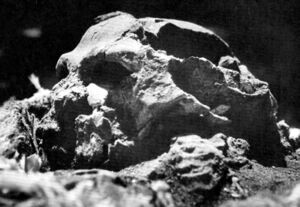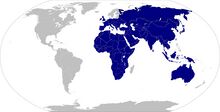Pangaean Code: Difference between revisions
(Created page with "[testing] ==Introduction== <!-- Design goals, inspiration, ideas, who speaks it?, when was it created?, where does it come from?, any peculiarities? --> <!-- Example categories/headings: Goals Setting Inspiration --> <!-- ***Phonology*** --> <!-- What sounds does your language use? --> <!-- Here are some example sub-/other categories: Vowel inventory Consonant inventory Syllable structure Stress Intonation --> ==Phonology== *instead of {pʼ tʼ kʼ}, ejective...") |
|||
| (30 intermediate revisions by the same user not shown) | |||
| Line 1: | Line 1: | ||
[ | {{Construction}} | ||
{{Infobox language | |||
|image = Shanidar1.jpg | |||
|imagesize = 300px | |||
|imagecaption = Photographed skull of [[w:Shanidar Cave|Shanidar I]] | |||
|name = Pangaean Code | |||
|altname = Codex | |||
|setting = Middle-East (?) | |||
|speakers = - | |||
|date = 2024 | |||
|created = {{gcl|c.|circa}} 50,000-12,000 BP | |||
|creator = Veno | |||
|map = Codex.jpg | |||
|mapcaption = Map of areas where the Codex is believed to have once been spoken | |||
}} | |||
'''Pangaean''', also referred to as the '''Codex''' or '''Primordial Language''', is a [[Philosophical language|philosophical]] [[ab interiori language]] of the [[w:Upper Paleolithic|Upper Paleolithic]] that consists on codifying the [[w:Alphabet of human thought|alphabet of thought]] into articulated sounds. Its creator, [[User:Veno|Veno]], named it after the hypothesis of [[Paleolithic Codes]], wherein the language would be the oldest one. | |||
The Codex is very similar to [[w:Gottfried Wilhelm Leibniz|Gottfried Wilhelm Leibniz]]' idealization of a [[w:Characteristica Universalis|Characteristica Universalis]], although the presence of [[w:Mnemonic|Mnemonics]] and [[w:Sound symbolism|Sound Symbolism]] may set it apart from a genuine [[w:Calculus ratiocinator|calculus ratiocinator]]. Meaningful units are mimetic rather than numeric (called [[w:Phememe|phememes]]), whose discussion first appeared in [[w:Plato|Plato]]'s [[w:Cratylus (dialogue)|Cratylus]] before being developed in the 20<sup>th</sup> Century by anthropologist [[w:Mary LeCron Foster|Mary LeCron Foster]]. With those phememes [...] | |||
[...] | |||
Other constructed languages similar to the Pangaean Code include [[w:Ithkuil|Ithkuil]] (in morphological complexity), [[w:Lojban|Lojban]] (in syntactic complexity), and [[w:IEML|IEML]] (in semantic complexity). | |||
<!-- | |||
Based on the dawn | |||
IEML | |||
believes it to be the oldest of the Paleolithic Codes, created dawn of the [[w:Upper Paleolithic|Upper Paleolithic]] | |||
Characteristica Universalis | |||
--> | |||
==Introduction== | ==Introduction== | ||
| Line 28: | Line 56: | ||
==Phonology== | ==Phonology== | ||
==Morphology== | ==Morphology== | ||
< | ''√k'' as a sound [§ I.I.I.I.□<sub>111</sub>] or as a morphological actor [§ I.U.I.I.□<sub>1131</sub>]... | ||
==Syntax== | |||
==Cavetalk== | |||
/naik huiuzu aio/ | |||
==Example texts== | ==Example texts== | ||
<!-- An example of a translated or unique text written in your language. Again, it is recommended that you make sure that the phonology, constraints, phonotactics and grammar are more or less finished before writing. --> | <!-- An example of a translated or unique text written in your language. Again, it is recommended that you make sure that the phonology, constraints, phonotactics and grammar are more or less finished before writing. --> | ||
==Other resources== | ==Other resources== | ||
<!-- Example: Word order, qualifiers, determinatives, branching, etc. --> | <!-- Example: Word order, qualifiers, determinatives, branching, etc. --> | ||
Revision as of 19:45, 30 December 2024
This article is a construction site. This project is currently undergoing significant construction and/or revamp. By all means, take a look around, thank you. |
| Pangaean Code | |
|---|---|
| Codex | |
 Photographed skull of Shanidar I | |
| Created by | Veno |
| Date | c. 50,000-12,000 BP |
| Setting | Middle-East (?) |
| Native speakers | - (2024) |
Default
| |
Map of areas where the Codex is believed to have once been spoken | |
Pangaean, also referred to as the Codex or Primordial Language, is a philosophical ab interiori language of the Upper Paleolithic that consists on codifying the alphabet of thought into articulated sounds. Its creator, Veno, named it after the hypothesis of Paleolithic Codes, wherein the language would be the oldest one.
The Codex is very similar to Gottfried Wilhelm Leibniz' idealization of a Characteristica Universalis, although the presence of Mnemonics and Sound Symbolism may set it apart from a genuine calculus ratiocinator. Meaningful units are mimetic rather than numeric (called phememes), whose discussion first appeared in Plato's Cratylus before being developed in the 20th Century by anthropologist Mary LeCron Foster. With those phememes [...]
[...]
Other constructed languages similar to the Pangaean Code include Ithkuil (in morphological complexity), Lojban (in syntactic complexity), and IEML (in semantic complexity).
Introduction
Phonology
Morphology
√k as a sound [§ I.I.I.I.□111] or as a morphological actor [§ I.U.I.I.□1131]...
Syntax
Cavetalk
/naik huiuzu aio/

